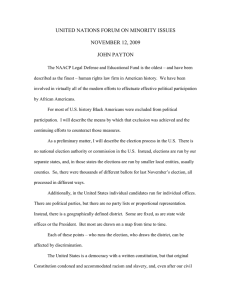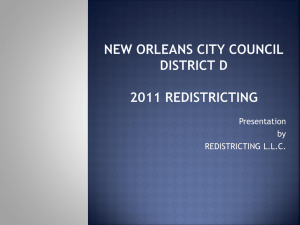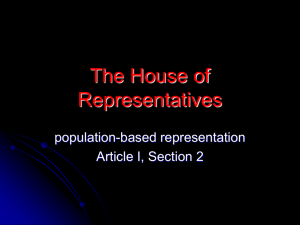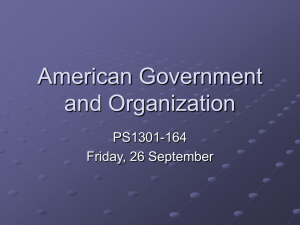Lecture 8
advertisement
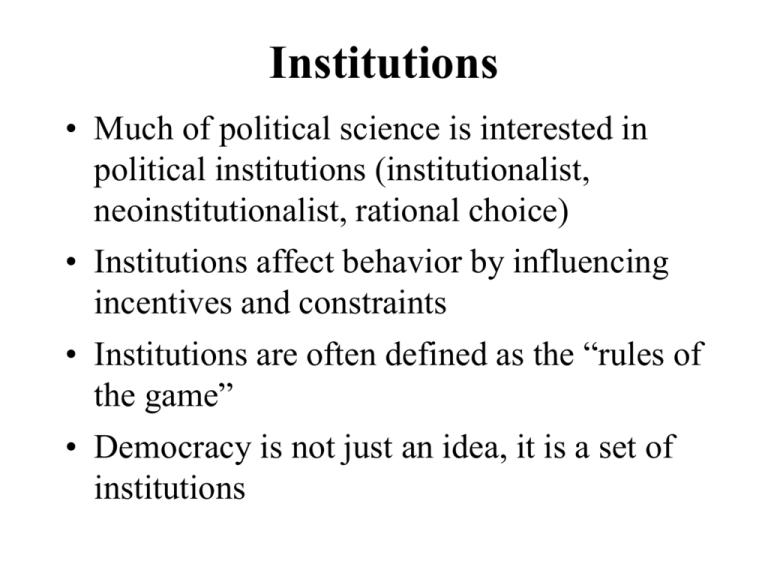
Institutions • Much of political science is interested in political institutions (institutionalist, neoinstitutionalist, rational choice) • Institutions affect behavior by influencing incentives and constraints • Institutions are often defined as the “rules of the game” • Democracy is not just an idea, it is a set of institutions Pathologies of our political Institutions • Create barriers for representation • Choke points for women and minorities – Primary system – Incumbency advantage – Size of Congress – Large, expensive districts to run in – Method of electing representatives (SMPD) Primary System Who decides who will represent the political party? Party elites or voters? Having a primary may seem more democratic, but many democracies leave the decision to party elites. Those systems (e.g., Sweden) often have better representation of minorities and women. Primaries, although open, act as choke points. Congress: Large Districts/Few Seats • Germany, Brazil, Russia, Japan, Mexico, France, Italy, UK, Poland, all have more members even though they have smaller populations • Prior to 1915, the House grew in tandem with the population • Only India (a nation of over 1 billion people) has more constituents per representative than the U.S. • Has the U.S. become the second most “underrepresentative” democracy in the world? • Restricting the size of Congress can act as another choke point Incumbency Advantage • 95%+ members of the HR get reelected • Term limits: – Creates more “open” seats, therefore increases electoral competitions – Women and Minorities have found it easier to get elected (more open seats) ELECTING REPRESENTATIVES Team Ticket Ballot: -Vote for Party, not candidate -Party/Issue centered campaigns -Easier to vote, less information required -Women and Minorities may find it easier to get elected Proportional Representation What would need to be done?: Multiple members per district (at least 3) Types of PR: Mixed Member Proportional (SMPD & PR seats) Single Transferable Vote (rank order) Cumulative voting (multiple votes) Bowler and Donovan - Cumulative Voting What is cumulative voting? • Why would we want to adopt it? • increase minority representation • more likely to represent a voters multiple preferences Cumulative Voting • Increase turnout • Political efficacy • Can get rid of local districts and have atlarge elections without harming minorities • Racial gerrymandering becomes unnecessary • Doesn't really work with single member districts so would require some adjustment Cumulative Voting • Why might we not want it? • complicated • doesn’t always lead to more minority representatives (Latinos?) • Doesn't really work with single member districts so would require some adjustment • But changing SMPD doesn’t require constitutional amendment Redistricting • Grofman deals with 3 issues related to redistricting: – 1. how to operationalize "realistic opportunity to elect candidates of choice,” – 2. changing census categories, – 3. how to count minorities Redistricting • Why the increase in majority-minority districts? – 1. computer map making ability – 2. more minority members already in legislators ready to support the issue – 3. Republicans supporting the idea – 4. aggressive enforcement of the voting rights act by the DOJ Redistricting 1. How do we operationalize "realistic opportunity" (Voting Rights Act section 2) – Effects-tests (at-large vs. multi-member) – historic trends (what size is needed?) – taking into account voter turnout not just size – observing white cross-over voting How should we count 1. Count or Sampling – statistical sampling is not perfect; how to choose method, weighting system? If we choose one prior to the count we might find that a different formula is better. Perception of manipulation. – For redistricting; the points are moot; more people doesn't mean more voters; generally concentrated in areas where they will make no difference (already heavily minority districts). – Grofman is really not convinced it will make a difference: rounding rules; some states with large minority groups are not controlled by democrats. Midterm • Essay Exam • Writing 101 • Clarity • Organization – Introductory paragraph – Body (each point/argument is a paragraph) – Concluding paragraph • Paragraphs should have structure – Introduction, body, conclusion Midterm • Cite readings – (Banducci, Donovan, Karp, p. ?) • Length? – Cover main points • 5 paragraph minimum – paragraphs should have about 5 sentences • Clear, concise, organized, well-cited essays will get higher grades than long-winded, unorganized essays with few cites.

